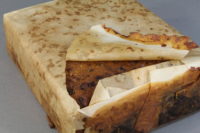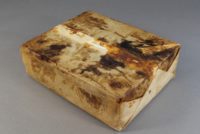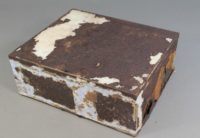 Fruit cakes are famous for their longevity, mainly because they start off close to inedible so it takes years for them to cross the line into fully inedible. Conservators with the Antarctic Heritage Trust (AHT) have found a 106-year-old fruit cake in a 19th century hut on Cape Adare. It looks remarkably well-preserved, although none of the conservators have sampled the confection.
Fruit cakes are famous for their longevity, mainly because they start off close to inedible so it takes years for them to cross the line into fully inedible. Conservators with the Antarctic Heritage Trust (AHT) have found a 106-year-old fruit cake in a 19th century hut on Cape Adare. It looks remarkably well-preserved, although none of the conservators have sampled the confection.
The hut is the oldest structure in Antarctica. The Borchgrevink huts are the only surviving first constructions by humans on a continent. It is one of two structures built by the Norwegian pioneer of polar exploration Carsten Borchgrevink in 1899 and used by later explorers. AHT experts believe the cake dates to the Terra Nova expedition (1910-1913), explorer Robert Falcon Scott’s calamitous final expedition to the South Pole. He and four others reached the South Pole on January 17th, 1912 only to find to their dismay that Norwegian explorer Roald Amundsen and his team had gotten there a month earlier on December 14th, 1911. Scott and his men died on the return voyage when their dog teams failed to meet them at the pre-determined rendezvous spot.
 The fruitcake was made by the Huntley & Palmers company, purveyors of sweet treats since 1822, and Huntley & Palmers cakes are known to have been among the supplies for the Terra Nova expedition. Scott himself didn’t go to Cape Adare. It was First Officer Victor Campbell’s Northern Party who sheltered in Borchgrevink’s hut and used it to hold their stores in the summer and winter of 1911. When the party was picked up in January of 1912, they left tinned supplies behind.
The fruitcake was made by the Huntley & Palmers company, purveyors of sweet treats since 1822, and Huntley & Palmers cakes are known to have been among the supplies for the Terra Nova expedition. Scott himself didn’t go to Cape Adare. It was First Officer Victor Campbell’s Northern Party who sheltered in Borchgrevink’s hut and used it to hold their stores in the summer and winter of 1911. When the party was picked up in January of 1912, they left tinned supplies behind.
The New Zealand-based Antarctic Heritage Trust began a project in May 2016 to recover and conserve all the artifacts in the Cape Adare huts before the huts themselves are conserved. Because the site is an Antarctic Specially Protected Area (ASPA), the objects will all be returned to their original locations after the conservation of the buildings is complete.
 The complexity of the project and the short seasons of the polar environment required stringent deadlines for everything to get done on time. The team has conserved close to 1,500 artifacts between May of last year and July of this year. The fruit cake was one of the last ones and conservators had no idea what it was because the tin was so corroded the label and brand could not be identified. It was only when they opened the tin that they saw it was a Huntley & Palmers fruit cake still in its original paper wrapper.
The complexity of the project and the short seasons of the polar environment required stringent deadlines for everything to get done on time. The team has conserved close to 1,500 artifacts between May of last year and July of this year. The fruit cake was one of the last ones and conservators had no idea what it was because the tin was so corroded the label and brand could not be identified. It was only when they opened the tin that they saw it was a Huntley & Palmers fruit cake still in its original paper wrapper.
Conservation treatment involved rust removal, chemical stabilisation and coating of the tin remnants. Deacidification of the tin label and some physical repair to the torn paper wrapper and tin label was also carried out. The cake itself was in excellent condition.
Programme Manager-Artefacts Lizzie Meek said “With just two weeks to go on the conservation of the Cape Adare artefacts, finding such a perfectly preserved fruitcake in amongst the last handful of unidentified and severely corroded tins was quite a surprise. It’s an ideal high-energy food for Antarctic conditions, and is still a favourite item on modern trips to the Ice.”